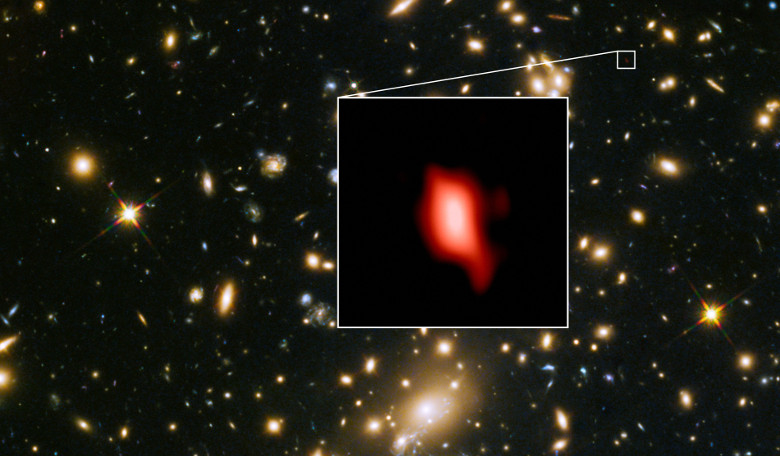Pinning down the star formation history of the Universe is a challenging task, but astronomers studying the very distant galaxy MACS1149-JD have detected the most distant oxygen ever detected from stars that had begun forming a mere 250 million years after the Big Bang.
The stars pumping out oxygen in MACS1149-JD1 are calculated to be approximately 13.3 billion years old, so around 500 million years after the Big Bang, but naturally to reach a stage of emitting oxygen they must have formed much earlier – about 250 million years earlier, say the international team of astronomers who spotted them.
To work this out, the team whose lead author is Takuya Hashimoto, a researcher at both Osaka Sangyo University and National Astronomical Observatory of Japan, reconstructed the earlier history of MACS1149-JD1 using infrared data taken with the Hubble Space telescope and NASA's Spitzer Space Telescope. After modelling the data, Hashimoto and colleagues found that the observed brightness of the galaxy correlates to a period where the onset of star formation began around 250 million years after the Universe began.
The discovery of the oldest oxygen signal ever detected by any telescope is a tantalising one, as the very first stars are expected to be composed mainly of the lightest elements that were around in the Universe at that time; hydrogen and helium. Heavier elements such as carbon, oxygen and nitrogen only appeared after being created by fusion processes deep within the first stars. These atoms then permeated the Universe after those first stars died, and were incorporated into the next generation of star formation processes.
The ionised oxygen from stars in MACS1149-JD1 therefore means that there must have been an even earlier generations of stars before these ones. Which leads back to the question of when did the very first galaxies emerge from an epoch known as the “cosmic dawn” – a period of total darkness that followed after the Big Bang.
“Determining when cosmic dawn occurred is akin to the Holy Grail of cosmology and galaxy formation. With these new observations of MACS1149-JD1 we are getting closer to directly witnessing the birth of starlight! Since we are all made of processed stellar material, this is really finding our own origins,” said Richard Ellis, senior astronomer at UCL and co-author of the new paper detailing this research.
This discovery also represents the most distant galaxy ever observed by the observatories that studied it; ESO’s Very Large Telescope (VLT) and the Atacama Large Millimeter/submillimeter Array (ALMA) – an array that has already set the record for detecting the most distant oxygen several times before.
“I was thrilled to see the signal of the distant oxygen in the ALMA data,” says Hashimoto. “This detection pushes back the frontiers of the observable Universe.”
Along with the ancient oxygen signal, the VLT also picked up a weaker signal of hydrogen emission which is consistent with the distance from the oxygen observation. The two signals together makes MACS1149-JD1 the most distant galaxy with a precise distance measurement.
“This galaxy is seen at a time when the Universe was only 500 million years old and yet it already has a population of mature stars,” explains Nicolas Laporte, a researcher at University College London (UCL) in the UK and second author of the new paper. “We are therefore able to use this galaxy to probe into an earlier, completely uncharted period of cosmic history.”











